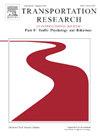老年司机超速行为的研究:功能能力、个性和驾驶环境的作用
IF 4.4
2区 工程技术
Q1 PSYCHOLOGY, APPLIED
Transportation Research Part F-Traffic Psychology and Behaviour
Pub Date : 2025-04-30
DOI:10.1016/j.trf.2025.04.021
引用次数: 0
摘要
功能能力、人格特征和驾驶环境对老年驾驶员超速倾向影响的证据有限。这项研究调查了老年司机的各种超速行为,并研究了这些行为的预测因素。超速事件定义为以超过限速的任何速度行驶至少6秒。超速事件是从58名年长司机的驾驶数据中提取出来的,这些数据是由驾驶记录仪收集的。然后根据严重程度和持续时间将这些事件分为短期轻微事件、短期主要事件和长期超速事件。采用混合效应模型分析了出行层面超速行为的预测因子。我们的研究结果表明,参与者平均每100公里发生15.9起超速事件,其中短时间超速在30-40公里/小时的区域最常见,而长时间超速在60和80公里/小时的道路上更常见。旅行特征反映了每次旅行的驾驶环境,在预测老年驾驶员的超速行为中起着至关重要的作用。研究发现,除了夜间驾驶外,大多数引发其他年龄段超速行为的驾驶环境对老年司机也有类似的影响。大多数老年司机倾向于在夜间减少所有三种超速行为的参与,而且自我调节的程度因人而异。此外,造路测试B部分表现较差的驾驶员不太可能进行短时间的主要超速。然而,没有发现感觉寻求或冲动与三种超速行为中的任何一种有显著关联。这些发现表明,在大多数有利于这些行为的环境中,老年司机可能无法控制超速,他们可能没有完全认识到超速带来的风险增加。本文章由计算机程序翻译,如有差异,请以英文原文为准。
Exploring speeding behaviors of older drivers: Role of functional abilities, personality, and driving environments
Evidence on the influence of functional abilities, personality traits and driving environments on older drivers’ propensity for speeding is limited. This study examined various types of speeding behaviors in older drivers and examined predictors of these behaviors. A speeding event was defined as driving at any speed above the speed limit for at least 6 s. Speeding events were extracted from the driving data of 58 older drivers, collected by driving recorders. These events were then categorized into short-duration minor, short-duration major, and long-duration speeding events based on both severity and duration. Mixed-effect models were employed to analyze the predictors of speeding behaviors at the trip level. Our findings indicated that participants were involved in an average of 15.9 speeding events per 100 km, with short-duration speeding most common in 30–40 km/h zones, while long-duration speeding occurred more frequently on 60 and 80 km/h roads. Trip characteristics, which reflected the driving environments of each trip, played a crucial role in predicting older drivers’ speeding behaviors. Most driving environments that trigger speeding behaviors in other age groups were found to similarly impact older drivers, except for nighttime driving. Most older drivers tend to reduce their involvement in all three categories of speeding behaviors at night, and the degree of self-regulation varies across individuals. Moreover, drivers with poorer trail-making test part B performance were less likely to engage in short-duration major speeding. However, no significant associations were found between sensation seeking or impulsivity and any of the three categories of speeding behaviors. These findings suggest that older drivers may not be able to refrain from speeding in most environments that are conducive to these behaviors, and they may not fully recognize the increased risks associated with speeding.
求助全文
通过发布文献求助,成功后即可免费获取论文全文。
去求助
来源期刊
CiteScore
7.60
自引率
14.60%
发文量
239
审稿时长
71 days
期刊介绍:
Transportation Research Part F: Traffic Psychology and Behaviour focuses on the behavioural and psychological aspects of traffic and transport. The aim of the journal is to enhance theory development, improve the quality of empirical studies and to stimulate the application of research findings in practice. TRF provides a focus and a means of communication for the considerable amount of research activities that are now being carried out in this field. The journal provides a forum for transportation researchers, psychologists, ergonomists, engineers and policy-makers with an interest in traffic and transport psychology.

 求助内容:
求助内容: 应助结果提醒方式:
应助结果提醒方式:


